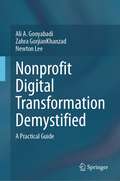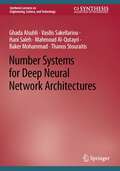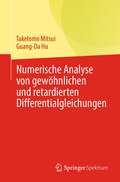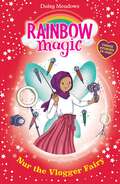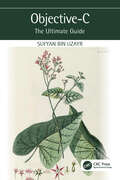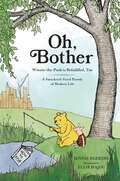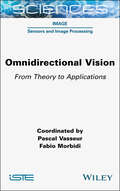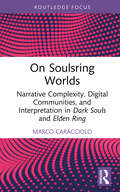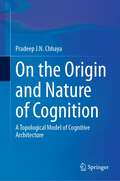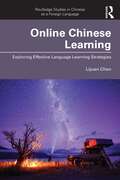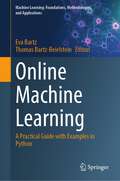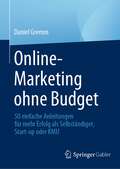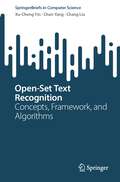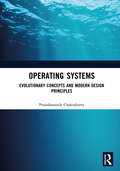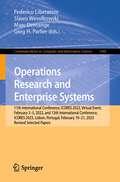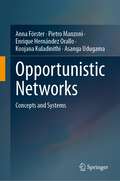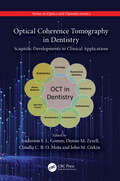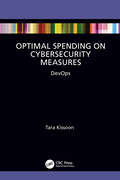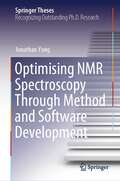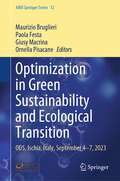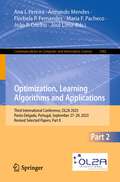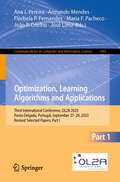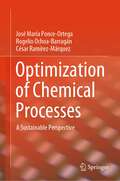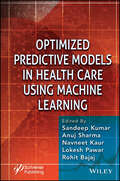- Table View
- List View
Nonprofit Digital Transformation Demystified: A Practical Guide
by Ali A. Gooyabadi Zahra GorjianKhanzad Newton LeeIn this compelling journey into Digital Transformation (DT) tailored for Nonprofit Organizations (NPOs), this book unravels the intricacies of technological integration. Grounded in over one hundred years of extensive research by authors and the editor, real-world examples, and using the San Diego Diplomacy Council (SDDC) as a primary case study, it introduces a tailored Digital Maturity Model (DMM) for NPOs. At the heart of this transformation are three pivotal pillars: Culture, Ethics, and Security.Part I sets the stage, painting a landscape of how NPOs have intertwined with the digital realm. As technology's omnipresence surges, Chapter Two offers a panorama of DT's historical and contemporary intersections with the nonprofit sector. The subsequent chapter emphasizes the stark reality: for many NPOs, digital adaptation is no longer about relevance but survival.Part II delves into the comparative digital strategies of NPOs and their for-profit counterparts in Chapter 4, highlighting the need for tailored approaches. Chapter 5 explores the Nonprofit Digital Maturity Model (NDMM), using the San Diego Diplomacy Council as a focal point. The journey then unfolds further in Chapter 6, which casts a spotlight on the strategic execution of DT in NPOs, weaving in comprehensive analyses to dissect the forces shaping an NPO's digital trajectory.Part III dives deeper, with Chapter 7 laying the foundation of the NDMM. The subsequent chapter meticulously unpacks the NDMM, culminating in Chapter 9, which emphasizes the pillars of DT—Culture, Ethics, and Security—forming the essence of the Nonprofit DT Strategic Framework (NDTSF). This chapter also crafts a tailored roadmap for NPOs, charting a comprehensive DT course.Concluding with a forward-looking stance, Chapter 10 thrusts readers into the enthralling fusion of AI and NPOs, exploring transformative potentials and ethical concerns. Through real-world cases, it positions AI as both a potent tool and a vital dialogue for NPOs. Essentially, this book equips NPOs with tools like the NDMM and insights from successful DT narratives. It seeks to provide a practical guide for nonprofits through their DT journey, ensuring they harness technology ethically and effectively without compromising their core values.
Number Systems for Deep Neural Network Architectures (Synthesis Lectures on Engineering, Science, and Technology)
by Ghada Alsuhli Vasilis Sakellariou Hani Saleh Mahmoud Al-Qutayri Baker Mohammad Thanos StouraitisThis book provides readers a comprehensive introduction to alternative number systems for more efficient representations of Deep Neural Network (DNN) data. Various number systems (conventional/unconventional) exploited for DNNs are discussed, including Floating Point (FP), Fixed Point (FXP), Logarithmic Number System (LNS), Residue Number System (RNS), Block Floating Point Number System (BFP), Dynamic Fixed-Point Number System (DFXP) and Posit Number System (PNS). The authors explore the impact of these number systems on the performance and hardware design of DNNs, highlighting the challenges associated with each number system and various solutions that are proposed for addressing them.
Numerische Analyse von gewöhnlichen und retardierten Differentialgleichungen
by Taketomo Mitsui Guang-Da HuDieses Buch dient als prägnantes Lehrbuch für Studenten in einem fortgeschrittenen Undergraduate- oder First-Year-Graduate-Kurs in verschiedenen Disziplinen wie angewandte Mathematik, Steuerung und Ingenieurwesen, die den modernen Standard der numerischen Methoden von gewöhnlichen und verzögerten Differentialgleichungen verstehen wollen. Experten in denselben Bereichen können sich auch über die jüngsten Entwicklungen in der numerischen Analyse solcher Differentialsysteme informieren. Gewöhnliche Differentialgleichungen (ODEs) sind ein starkes mathematisches Werkzeug, um eine Vielzahl von Phänomenen in Wissenschaft und Technik auszudrücken. Neben ihrer eigenen Bedeutung ist eine der mächtigen Richtungen, in die sich ODEs ausdehnen, die Einbeziehung einer unbekannten Funktion mit verzögertem Argument. Dies wird als verzögerte Differentialgleichungen (Delay differential equations, DDEs) bezeichnet, die häufig in der mathematischen Modellierung vonBiologie, Demographie, Epidemiologie und Kontrolltheorie vorkommen. In einigen Fällen kann die Lösung einer Differentialgleichung durch algebraische Kombinationen bekannter mathematischer Funktionen erhalten werden. In vielen praktischen Fällen ist eine solche Lösung jedoch recht schwierig oder nicht verfügbar, und es sind numerische Näherungen erforderlich. Die moderne Entwicklung von Computern beschleunigt die Situation und eröffnet darüber hinaus mehr Möglichkeiten der numerischen Mittel. Die Kenntnis und das Fachwissen über die numerische Lösung von Differentialgleichungen wird nun in weiten Bereichen der Wissenschaft und des Ingenieurwesens vorausgesetzt.Man könnte meinen, dass ein gut organisiertes Softwarepaket wie MATLAB in etwa die gleiche Lösung bietet. In gewisser Weise stimmt das auch, aber man muss bedenken, dass der blinde Einsatz von Softwarepaketen den Benutzer in die Irre führt. Das Wesentliche der numerischen Lösung von Differentialgleichungen muss noch gelernt werden. Das vorliegende Buch soll das Wesentliche der numerischen Lösungen von gewöhnlichen Differentialgleichungen sowie von Verzögerungsdifferentialgleichungen vermitteln. Die Autoren haben insbesondere festgestellt, dass es noch wenige prägnante Lehrbücher über Verzögerungsdifferentialgleichungen gibt, und haben sich dann daran gemacht, die Lücke durch möglichst transparente Beschreibungen zu schließen. Die wichtigsten Algorithmen zur numerischen Lösung sind in diesem Buch klar beschrieben. Auch die Stabilität von Lösungen von ODEs und DDEs ist von entscheidender Bedeutung. Das Buch führt in die asymptotische Stabilität von analytischen und numerischen Lösungen ein und bietet einen praktischen Weg zur Analyse ihrer Stabilität unter Verwendung einer Theorie komplexer Funktionen.
Nur the Vlogger Fairy (Rainbow Magic #1154)
by Daisy MeadowsNur the Vlogger Fairy is planning Fairyland's biggest vlogger meet-up ever - Magic Vlog Con! But jealous Jack Frost wants to become a vlogging superstar and has stolen Nur's magical objects. Without them, vloggers can't make fun videos. Nur needs Rachel, Kirsty, Gracie and Khadijah's help to get her enchanted objects back and show Jack Frost that vlogging is for expressing yourself, not becoming famous. Can the fairy friends find Nur's lucky ring light, her cool camera and her magic microphone and save Magic Vlog Con? 'These stories are magic; they turn children into readers!' ReadingZone.comIf you like Rainbow Magic, check out Daisy Meadows' other series: Magic Animal Friends and Unicorn Magic!
Objective-C: The Ultimate Guide (The Ultimate Guide)
by Sufyan bin UzayrObjective-C is a general-purpose, object-oriented programming language that extends the C programming language with Smalltalk-style messaging. While simultaneously developing for OS X and iOS, Objective-C's capabilities have been bolstered by the inclusion of a dynamic runtime and assistance for object-oriented programming. Objective-C: The Ultimate Guide walks developers and coders through a straightforward and practical method of learning the Objective-C programming language. This book discusses the basics in brief, and then moves on to more advanced and detailed exercises to help readers quickly gain the required knowledge. The focus in this book remains on writing optimized and well-structured code in Objective-C. Key Features: Follows a hands-on approach and offers practical lessons and tutorials related to Objective-C Discusses Objective-C using real world industry concepts Includes at-length discussion of Objective-C concepts to help build robust knowledge
The Official Stardew Valley Cookbook
by ConcernedApe Ryan NovakThe first official cookbook from the immensely popular Stardew Valley, featuring more than 50 delightful recipes straight out of the video game.&“Hungry? Thirsty? I&’ve got just the thing!&”—Gus Welcome to Stardew Valley, where each season brings a new crop of bountiful food to make for friends and family. From farm staples like veggies, fruit, milk, and eggs to foraged mushrooms and berries to fresh fish, there&’s always something delicious to put on the table. These 50 recipes are based on in-game meals and food, allowing you to cook and eat all your home-grown and fresh-caught ingredients in real life. The Official Stardew Valley Cookbook is organized by season and has recipes from your favorite characters, including the Queen of Sauce and Gus at the Stardrop Saloon. Written in collaboration with independent game creator ConcernedApe and packed with original illustrations and food photography, The Official Stardew Valley Cookbook helps you bring the Valley&’s incredible flavors to the dinner table, giving you the energy to take on the world.
Oh, Bother: Winnie-the-Pooh is Befuddled, Too (A Smackerel-Sized Parody of Modern Life)
by Jennie EgerdieWelcome back to the Hundred Acre Wood as Winnie-the-Pooh and friends acclimate to the joys and worries of the 21st century in this heartfelt parody. The world has changed in the hundred years since A. A. Milne introduced us to Winnie-the-Pooh and his pals, but that doesn&’t mean our lovable friends haven&’t adapted to life in the twenty-first century. In this heartwarming, laugh-out-loud parody, Jennie Egerdie, author of the celebrated Frog and Toad are Doing Their Best, takes us along for some marvelous misadventures as the gang grapples with modern life&’s headaches and pesky predicaments. Like the rest of us, Pooh worries about what the dwindling bee population will do to his beloved honey, while Owl discovers how far too easily misinformation can spread online. Kanga hopes she can have a night off from raising Roo, and Eeyore is finally taking care of his mental health with the help of Dr Festinker, the neighborhood therapist (and skunk). Things may not always make sense in our world, but Winnie-the-Pooh always bounds ahead, day by day and smackeral by smackeral.
Omnidirectional Vision: From Theory to Applications
by Pascal Vasseur Fabio MorbidiOmnidirectional cameras, vision sensors that can capture 360° images, have in recent years had growing success in computer vision, robotics and the entertainment industry. In fact, modern omnidirectional cameras are compact, lightweight and inexpensive, and are thus being integrated in an increasing number of robotic platforms and consumer devices. However, the special format of output data requires tools that are appropriate for camera calibration, signal analysis and image interpretation. This book is divided into six chapters written by world-renowned scholars. In a rigorous yet accessible way, the mathematical foundation of omnidirectional vision is presented, from image geometry and camera calibration to image processing for central and non-central panoramic systems. Special emphasis is given to fisheye cameras and catadioptric systems, which combine mirrors with lenses. The main applications of omnidirectional vision, including 3D scene reconstruction and robot localization and navigation, are also surveyed. Finally, the recent trend towards AI-infused methods (deep learning architectures) and other emerging research directions are discussed.
On Soulsring Worlds: Narrative Complexity, Digital Communities, and Interpretation in Dark Souls and Elden Ring (ISSN)
by Marco CaraccioloThe first book-length study devoted to FromSoftware games, On Soulsring Worlds explores how the Dark Souls series and Elden Ring are able to reconcile extreme difficulty in both gameplay and narrative with broad appeal.Arguing that the games are strategically positioned in relation to contemporary audiences and designed to tap into the new forms of interpretation afforded by digital media, the author situates the games vis-à-vis a number of current debates, including the posthuman and the ethics of gameplay. The book delivers an object lesson on the value of narrative (and) complexity in digital play and in the interpretive practices it gives rise to.Cross-fertilizing narrative theory, game studies, and nonhuman-oriented philosophy, this book will appeal to students and scholars of game studies, media studies, narratology, and video game ethnography.
On the Origin and Nature of Cognition: A Topological Model of Cognitive Architecture
by Pradeep J.N. ChhayaThis monograph is an extension of the earlier monographs dealing with the application of the new modified involuted manifold model. This monograph has two objectives. Firstly, it seeks to integrate neuronal organization with cognitive functionalities. Secondly, it tries to formalize a structural template of cognitive functionalities. It is based on the postulate that cognitive functionalities are essentially natural phenomena and therefore amenable to formal naturalistic description. Therefore, it employs a topological model of spacetime proposed earlier to define a new framework wherein neuronal networks occupy the four-dimensional configurations of spacetime, and cognitive functionalities occupy higher dimensional configurations of spacetime. Using the Darwinian conception of natural selection, the monograph outlines a model of natural selection operating at more than one level. Thus, natural selection at the four-dimensional configurations of spacetime leads to structural agnosticism so prevalent in neuronal organization. At the same time, natural selection at the higher dimensional configurations of spacetime leads to natural selection of cognitive functionalities. Since the proposed model offers a new computational paradigm formalized in another monograph, this monograph provides a new way to formalize cognitive computations.
Online Chinese Learning: Exploring Effective Language Learning Strategies (Routledge Studies in Chinese as a Foreign Language)
by Lijuan ChenOnline Chinese Learning aims to investigate the types of language learning strategies (LLSs) that online Chinese learners use across asynchronous and synchronous learning environments in different learning contexts.This book examines how the use of language learning strategies by online Chinese learners is influenced by the interactants; the characteristics of the specific learning context; and selected individual learner characteristics. This book will provide: (1) new and detailed information about students’ LLS use in online Chinese learning; (2) insights into how individual students adopt LLSs and technological tools to solve learning problems in various learning contexts; (3) an exploration of factors influencing LLS use; and (4) recommendations regarding LLS adoption, use, and training.This book will be a valuable resource for university instructors in languages, language teaching methods, and second language acquisition, as well as researchers in languages, linguistics, and language learning and teaching.
Online Machine Learning: A Practical Guide with Examples in Python (Machine Learning: Foundations, Methodologies, and Applications)
by Eva Bartz Thomas Bartz-BeielsteinThis book deals with the exciting, seminal topic of Online Machine Learning (OML). The content is divided into three parts: the first part looks in detail at the theoretical foundations of OML, comparing it to Batch Machine Learning (BML) and discussing what criteria should be developed for a meaningful comparison. The second part provides practical considerations, and the third part substantiates them with concrete practical applications. The book is equally suitable as a reference manual for experts dealing with OML, as a textbook for beginners who want to deal with OML, and as a scientific publication for scientists dealing with OML since it reflects the latest state of research. But it can also serve as quasi OML consulting since decision-makers and practitioners can use the explanations to tailor OML to their needs and use it for their application and ask whether the benefits of OML might outweigh the costs. OML will soon become practical; it is worthwhile to get involved with it now. This book already presents some tools that will facilitate the practice of OML in the future. A promising breakthrough is expected because practice shows that due to the large amounts of data that accumulate, the previous BML is no longer sufficient. OML is the solution to evaluate and process data streams in real-time and deliver results that are relevant for practice.
Online-Marketing ohne Budget: 50 einfache Anleitungen für mehr Erfolg als Selbständiger, Start-up oder KMU
by Daniel GremmDieses Buch ist dein Ratgeber und Leitfaden, mit dem du dein Online-Marketing mit leistbarem Aufwand systematisch zum Erfolg bringst, und zwar ganz ohne Budget!Du baust Dein eigenes Geschäft auf, brauchst dafür Online-Marketing, hast aber nicht viel Geld zur Verfügung? Du führst ein kleines Geschäft und willst jetzt endlich mit Online-Marketing starten, weißt aber noch nicht, wie das sinnvoll geht? Dann lies – und arbeite – mit diesem Buch!„Online-Marketing ohne Budget“ bietet dir 50 konkrete Anleitungen. Diese Anleitungen sind jeweils Marketingzielen zugeordnet, so dass du zielführend die für deine Situation bestmögliche Marketingidee in die Tat umsetzen kannst.Dieses Buch ist kein „Was-du-schon-immer-wissen-solltest-Buch“, sondern ein Arbeitsbuch. Wenn du es als Arbeitsbuch nutzt, dann wirst du dein Online-Marketing entscheidend voranbringen, versprochen!Jede Anleitung wird dir in drei einfachen Schritten beschrieben. Häufig erhältst du zudem auch einen Tipp für ein kostenloses Tool, das dich bei der Umsetzung unterstützt. Eine abschließende Checkliste nach jedem Kapitel hilft dir, den Überblick zu behalten und dich stetig in der Umsetzung zu halten. Aus dem Inhalt – jeweils 10 konkrete Marketing-Anleitungen zu den Zielen …Bekannter werden Traffic steigernMehr verkaufenKunden bindenMitarbeiter finden
Open-Set Text Recognition: Concepts, Framework, and Algorithms (SpringerBriefs in Computer Science)
by Xu-Cheng Yin Chun Yang Chang LiuIn real-world applications, new data, patterns, and categories that were not covered by the training data can frequently emerge, necessitating the capability to detect and adapt to novel characters incrementally. Researchers refer to these challenges as the Open-Set Text Recognition (OSTR) task, which has, in recent years, emerged as one of the prominent issues in the field of text recognition. This book begins by providing an introduction to the background of the OSTR task, covering essential aspects such as open-set identification and recognition, conventional OCR methods, and their applications. Subsequently, the concept and definition of the OSTR task are presented encompassing its objectives, use cases, performance metrics, datasets, and protocols. A general framework for OSTR is then detailed, composed of four key components: The Aligned Represented Space, the Label-to-Representation Mapping, the Sample-to-Representation Mapping, and the Open-set Predictor. In addition,possible implementations of each module within the framework are discussed. Following this, two specific open-set text recognition methods, OSOCR and OpenCCD, are introduced. The book concludes by delving into applications and future directions of Open-set text recognition tasks.This book presents a comprehensive overview of the open-set text recognition task, including concepts, framework, and algorithms. It is suitable for graduated students and young researchers who are majoring in pattern recognition and computer science, especially interdisciplinary research.
Operating Systems: Evolutionary Concepts and Modern Design Principles
by Pranabananda ChakrabortyThis text demystifies the subject of operating systems by using a simple step-by-step approach, from fundamentals to modern concepts of traditional uniprocessor operating systems, in addition to advanced operating systems on various multiple-processor platforms and also real-time operating systems (RTOSs). While giving insight into the generic operating systems of today, its primary objective is to integrate concepts, techniques, and case studies into cohesive chapters that provide a reasonable balance between theoretical design issues and practical implementation details. It addresses most of the issues that need to be resolved in the design and development of continuously evolving, rich, diversified modern operating systems and describes successful implementation approaches in the form of abstract models and algorithms. This book is primarily intended for use in undergraduate courses in any discipline and also for a substantial portion of postgraduate courses that include the subject of operating systems. It can also be used for self-study. Key Features • Exhaustive discussions on traditional uniprocessor-based generic operating systems with figures, tables, and also real-life implementations of Windows, UNIX, Linux, and to some extent Sun Solaris.• Separate chapter on security and protection: a grand challenge in the domain of today’s operating systems, describing many different issues, including implementation in modern operating systems like UNIX, Linux, and Windows.• Separate chapter on advanced operating systems detailing major design issues and salient features of multiple-processor-based operating systems, including distributed operating systems. Cluster architecture; a low-cost base substitute for true distributed systems is explained including its classification, merits, and drawbacks.• Separate chapter on real-time operating systems containing fundamental topics, useful concepts, and major issues, as well as a few different types of real-life implementations. • Online Support Material is provided to negotiate acute page constraint which is exclusively a part and parcel of the text delivered in this book containing the chapter-wise/topic-wise detail explanation with representative figures of many important areas for the completeness of the narratives.
Operations Research and Enterprise Systems: 11th International Conference, ICORES 2022, Virtual Event, February 3–5, 2022, and 12th International Conference, ICORES 2023, Lisbon, Portugal, February 19-21, 2023, Revised Selected Papers (Communications in Computer and Information Science #1985)
by Federico Liberatore Slawo Wesolkowski Marc Demange Greg H. ParlierThis book includes extended and revised versions of selected papers from the 11th and 12th editions of the International Conference on Operations Research and Enterprise Systems (ICORES 2022 and ICORES 2023). ICORES 2022 was held as a virtual event in February 2022, and ICORES 2023 was held in Lisbon, Portugal, in February 2023. The 5 full papers included in this book were carefully reviewed and selected from the 55 submissions for ICORES 2022, and 8 full papers were reviewed and selected from the 55 submissions for ICORES 2023. The papers are focused on operations research and enterprise systems.
Opportunistic Networks: Concepts and Systems
by Anna Förster Pietro Manzoni Enrique Hernández Orallo Koojana Kuladinithi Asanga UdugamaThis textbook provides an exhaustive exploration of Opportunistic Networks (OppNets). Divided into three parts, it starts with the foundational principles and metrics of OppNets, detailing their mobility and data dissemination. Significant focus is given to the security challenges faced by OppNets, including strategies to counter various attacks. The second part evaluates OppNets, introducing methods and metrics for assessment, theoretical and simulation models, and tools such as OMNeT++, The ONE and ns-3.This textbook also offers comparative analyses and discussions on benchmarking. The third part delves into the implementation of OppNets, discussing technologies from Mobile Ad Hoc Networks to satellite communication and their integration with cellular technologies like 4G, 5G and 6G. Detailed insight into device characterization reveals the potential and limitations of devices within OppNets. Practical applications of OppNets in scenarios such as disaster management, remotecommunication, IoT challenges, smart cities and satellite networks are presented as well. Through detailed discussions and case studies, readers gain a comprehensive understanding of the structure, operation and practical implications of OppNets. It equips readers with knowledge to appreciate the vast potential of OppNets in various applications and settings.This textbook targets advanced-level students and postdocs in computer science and electrical engineering as well as researchers, who are starting new in the area and need a comprehensive view of opportunistic networks. Practitioners who are interested in applying the concepts of opportunistic networks in their products and services, and would like to have a jump start into the development and applications of opportunistic networks will also want to purchase this book as a reference.
Optical Coherence Tomography in Dentistry: Scientific Developments to Clinical Applications (Series in Optics and Optoelectronics)
by Gomes, Anderson S. L.Optical Coherence Tomography (OCT), a method to "see inside of things" without destroying them, has been applied to subjects ranging from materials science to medicine. This book focuses on the biomedical application of OCT in dentistry, covering topics from dental materials to clinical practice. Since the introduction of the OCT method in ophthalmology in 1991, and then dentistry in 1998, developments in OCT methods, particularly in biomedical areas, have led to its dissemination worldwide. The chapters of this book cover the basics and recent global advances of OCT in dentistry, including an overview of the method and its use in cariology, restorative dentistry, dental materials, endodontics, pediatric dentistry, orthodontics, prosthodontics, soft oral tissues and nanodentistry. This book will be of interest to both newcomers in the field as well as those already working in OCT, either in research and/or the clinic. It will be of great use in courses on optical imaging applied to biomedical areas, particularly where it can provide real-life examples of the application of OCT.
Optimal Spending on Cybersecurity Measures: DevOps
by Tara KissoonOptimal Spending on Cybersecurity Measures: DevOps aims to discuss the integration of risk management methodologies within the DevOps process.This book introduces the cyber risk investment model, and the cybersecurity risk management framework within the DevOps process. This can be used by various stakeholders who are involved in the implementation of cybersecurity measures to safeguard sensitive data. This framework facilitates an organization’s risk management decision-making process to demonstrate the mechanisms in place to fund cybersecurity measures within DevOps practices, and demonstrates the application of the process using a case study: Cascade. This book also discusses the elements used within DevOps, DevSecOps, and will define a strategic approach to minimize cybersecurity risks within DevOps known as DevRiskOps.Features: Aims to strengthen the reader’s understanding of industry governance, risk and compliance practices. Incorporates an innovative approach to assess cyber security initiatives with DevOps. Explores the strategic decisions made by organizations when implementing cybersecurity measures and leverages an integrated approach to include risk management elements into DevOps.
Optimising NMR Spectroscopy Through Method and Software Development (Springer Theses)
by Jonathan YongThis book provides a comprehensive overview of Nuclear Magnetic Resonance (NMR) theory, its applications, and advanced techniques to improve the quality and speed of NMR data acquisition. In this book, the author expands his outstanding Ph.D. thesis and provides a valuable resource for researchers, professionals, and students in the field of NMR spectroscopy. The book covers quantum mechanics basics, and topics like density operators, pulse sequences, 1D pulse acquisition, INEPT (Insensitive nuclei enhancement by polarization transfer), product operators, and 2D NMR principles. It also explores innovative experiments like States HSQC (Heteronuclear Single Quantum Coherence) and echo-antiecho HSQC with gradients. In the subsequent chapters, the author discusses Pure Shift NMR, including PSYCHE (Pure Shift Yielded by Chirp Excitation) and its optimizations, such as waveform parameterization and time-reversal methods. The 'Discrete PSYCHE' approach and Ultrafast PSYCHE-iDOSY (Diffusion-ordered spectroscopy) are also highlighted. This book presents the POISE (Parameter Optimisation by Iterative Spectral Evaluation) software for real-time NMR experiment optimization, including pulse width calibration and Ernst angle optimization, and demonstrates applications across various NMR experiments. Lastly, the book examines accelerated 2D NMR data collection and the NOAH (NMR by Ordered Acquisition using 1H detection) supersequences, emphasizing automated pulse program creation using GENESIS (GENEration of Supersequences In Silico). Covered NMR experiments include 13C sensitivity-enhanced HSQC, 15N HMQC (Heteronuclear Multiple Quantum Coherence), dual HSQC, HSQC-TOCSY (Total Correlation Spectroscopy), HMBC (Heteronuclear Multiple Bond Correlation), and ADEQUATE (Adequate Sensitivity Double-Quantum Spectroscopy).
Optimization in Green Sustainability and Ecological Transition: ODS, Ischia, Italy, September 4–7, 2023 (AIRO Springer Series #12)
by Maurizio Bruglieri Paola Festa Giusy Macrina Ornella PisacaneThis book collects selected contributions of the “Optimization and Decision Science - ODS2023” international conference on the theme of optimization in green sustainability and ecological transition. ODS2023 was held in Ischia, 4–7 September 2023, and was organized by AIRO, the Italian Operations Research Society. The book offers new and original contributions on operations research, optimization, decision science, and prescriptive analytics from both a methodological and applied perspectives with a special focus on SDG related topics.It provides a state-of-the art on problem models and solving methods to address a widely class of real-world problems, arising in different application areas such as logistics, transportation, manufacturing, health, ICT and mobile networks, and emergency/disaster management. In addition, the scientific works collected in this book aim at providing significant contributions in the themes of sustainability, traffic and pollution reductions, and energy management.This book is aimed primarily at researchers and Ph.D. students in the Operations Research community. However, due to its interdisciplinary contents, this book is of high interest also for students and researchers from other disciplines, including artificial intelligence, computer sciences, finance, mathematics, and engineering as well as for practitioners facing complex decision-making problems in logistics, manufacturing production, and services.
Optimization, Learning Algorithms and Applications: Third International Conference, OL2A 2023, Ponta Delgada, Portugal, September 27–29, 2023, Revised Selected Papers, Part II (Communications in Computer and Information Science #1982)
by Ana I. Pereira Armando Mendes Florbela P. Fernandes Maria F. Pacheco João P. Coelho José LimaThis two-volume set CCIS 1981 and 1982 constitutes the refereed post-conference proceedings of the Third International Conference on Optimization, Learning Algorithms and Applications, OL2A 2023, held in Ponta Delgada, Portugal, in September 2023.The 66 revised full papers presented in these proceedings were carefully reviewed and selected from 162 submissions. The papers are organized in the following topical sections:Volume I:Machine learning; learning algorithms in engineering education; machine learning and data analysis in internet of things; optimization; optimization in the SDG context.Volume II:Computer vision based on learning algorithms; machine learning and AI in robotics; optimization in control systems design.
Optimization, Learning Algorithms and Applications: Third International Conference, OL2A 2023, Ponta Delgada, Portugal, September 27–29, 2023, Revised Selected Papers, Part I (Communications in Computer and Information Science #1981)
by Ana I. Pereira Armando Mendes Florbela P. Fernandes Maria F. Pacheco João P. Coelho José LimaThis two-volume set CCIS 1981 and 1982 constitutes the refereed post-conference proceedings of the Third International Conference on Optimization, Learning Algorithms and Applications, OL2A 2023, held in Ponta Delgada, Portugal, in September 2023.The 66 revised full papers presented in these proceedings were carefully reviewed and selected from 162 submissions. The papers are organized in the following topical sections:Volume I:Machine learning; learning algorithms in engineering education; machine learning and data analysis in internet of things; optimization; optimization in the SDG context.Volume II:Computer vision based on learning algorithms; machine learning and AI in robotics; optimization in control systems design.
Optimization of Chemical Processes: A Sustainable Perspective
by José María Ponce-Ortega Rogelio Ochoa-Barragán César Ramírez-MárquezThis textbook introduces readers to a comprehensive framework for the application of deterministic optimization strategies in the field of chemical processes, with a strong emphasis on sustainability.The book establishes a vital connection between fundamental deterministic optimization principles, optimization tools, and real-world application instances, all within the context of environmentally responsible practices. The approach put forth in this book is exceptionally versatile, allowing for the use of many optimization software and deterministic techniques.Contained in the book are many fundamental optimization concepts, encompassing linear programming, nonlinear programming, integer programming, and multi-objective optimization, all tailored to promote sustainable decision-making. Furthermore, the book provides practical examples illustrating the application of these techniques within sustainable chemical processes as tutorials.The textbook also explores the utilization of popular optimization software platforms such as GAMS, MATLAB, and Python, demonstrating how these tools can be leveraged for eco-friendly process optimization. Through this comprehensive framework, readers can not only acquire the skills needed to optimize a wide range of processes but also learn how to do so with sustainability at the forefront of their considerations. This approach streamlines the optimization process, eliminating unnecessary complications along the way and ensuring that environmental and ethical considerations are integral to the decision-making process.
Optimized Predictive Models in Health Care Using Machine Learning
by Sandeep Kumar Anuj Sharma Navneet Kaur Lokesh Pawar Rohit BajajOPTIMIZED PREDICTIVE MODELS IN HEALTH CARE USING MACHINE LEARNING This book is a comprehensive guide to developing and implementing optimized predictive models in healthcare using machine learning and is a required resource for researchers, healthcare professionals, and students who wish to know more about real-time applications. The book focuses on how humans and computers interact to ever-increasing levels of complexity and simplicity and provides content on the theory of optimized predictive model design, evaluation, and user diversity. Predictive modeling, a field of machine learning, has emerged as a powerful tool in healthcare for identifying high-risk patients, predicting disease progression, and optimizing treatment plans. By leveraging data from various sources, predictive models can help healthcare providers make informed decisions, resulting in better patient outcomes and reduced costs. Other essential features of the book include: provides detailed guidance on data collection and preprocessing, emphasizing the importance of collecting accurate and reliable data; explains how to transform raw data into meaningful features that can be used to improve the accuracy of predictive models; gives a detailed overview of machine learning algorithms for predictive modeling in healthcare, discussing the pros and cons of different algorithms and how to choose the best one for a specific application; emphasizes validating and evaluating predictive models; provides a comprehensive overview of validation and evaluation techniques and how to evaluate the performance of predictive models using a range of metrics; discusses the challenges and limitations of predictive modeling in healthcare; highlights the ethical and legal considerations that must be considered when developing predictive models and the potential biases that can arise in those models. Audience The book will be read by a wide range of professionals who are involved in healthcare, data science, and machine learning.
